The meaning of Slavic amulets. Russian amulets and their meaning.
For many epochs, not a single person, not a single hut, not a single yard in Ancient Russia could not be conceived without folk amulets. The Russian population firmly believed that it was thanks to them magical abilities they are reliably protected from all sorts of ailments, "evil eyes", natural disasters and any troubles, that wearing and using special talismans brings good luck.
Gradually, the point of view of people on the events happening around changed. The way of life, family environment, housing, as well as other main worldly landmarks changed. Only each time the eternal desire of a person to protect and save his family hearth and his relatives from troubles was preserved. Our ancestors implemented this through protective amulets. Moreover, they were put on at the birth of a child and did not part with them all their lives.
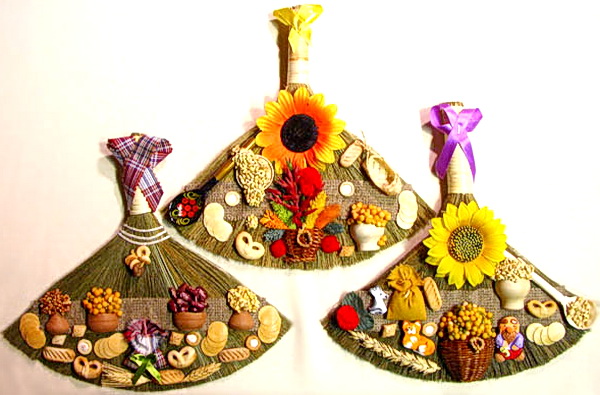
When placing buildings in the yard, they followed traditional rites, because a well-built house was actually the best protection against all sorts of sorrows and problems. Just like in the old days, so today, all people strive most of all to protect the courtyard of their house. The boundary of private space is steadily carried out along the fence around the courtyard and is protected by certain symbolic things. These include, in particular, horseshoes nailed to the gate, on doors, gates for luck, crucibles and krinks, shabby bast shoes, those that are hung on the fence, or nets that are thrown over the hedge or wattle fence.
Horseshoe - a charm for good luck
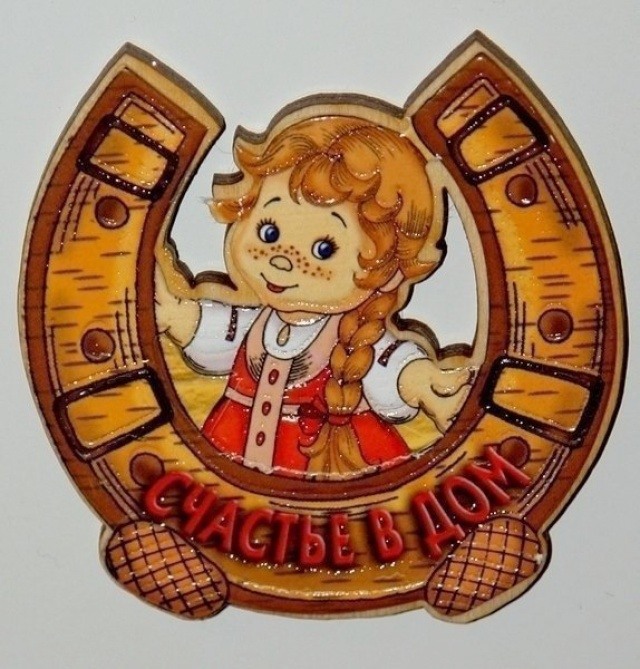
In Russia, since the time of Adam, a horseshoe has been attributed to an amulet of concomitant success, prosperity, and protection. And this is confirmed by various legends and beliefs. In bygone eras, when iron had just made its first steps into Europe, it was so expensive that any iron trinket was considered precious. However, this was not the main thing for a horseshoe, key factor consisted in the fact that she was forged by a blacksmith in a cleansing flame, and also that she was similar in configuration to a heavenly body and personified a young month.
Finding a horseshoe on the way was considered an exceptionally good omen. AT certain areas in addition, they observed specific actions in case of such a successful find: they picked up a horseshoe, spit on it, made a wish, threw it over their left shoulder and went home, in no case looking back. But this custom did not take root.
Different European peoples have their own legends about the importance of a horseshoe as a sign of fortune and prosperity. The most common among all of them is the Anglo-Saxon tradition of the immaculate Dunstan and the Evil One. Before Dunstan, the future Archbishop of Canterbury, the devil himself suddenly appeared and turned to him with a proposal to shoe his hooves. Dunstan, being also a blacksmith, agreed to such a procedure. Nevertheless, he shod the devil so firmly that he, feeling unimaginable pain, asked for mercy. In exchange for freedom, the demon promised that he would never enter the entrances, over which a horseshoe would hang. In all likelihood, the described Christian version of the role of the horseshoe as protecting things was adopted by Christians from the ancient idolatrous Celts, who assumed that a horseshoe nailed over the doors would be able to repel the penetration of otherworldly visitors.
AT Ancient Egypt and Babylon, a horseshoe resembling a new moon was considered to be a cult of the fertility goddesses Isis and Astarte.
She was always credited with some magical power, and most powerful personalities collected them. In the office of the Austrian emperor Ferdinand I, there was a large collection of all kinds of horseshoes. The current riders and riders want to save the horseshoe of the horse, on which they were lucky enough to win or set the highest record again.
By the way, how to hang a horseshoe?
Horns up or Horns down? And also, in which zone specifically to place it?
In modern times, such a talisman is used in every way:
- - a nailed amulet over the entrance doors with horns to the valley protects the dwelling from dashing;
- - horns up - attracts good luck to the family hearth;
- nailed on the inner and invisible side of the doors smooths out the fluid of housing, provided that there are geopathic places in it that are undesirable for the state of human health. For this, souvenir amulets are placed at the head of the sleeping areas;
- the talisman laid on the very first night of the full moon on the windowsill with the ends from the window, activates the attraction of finances into the house and by all means serves as a help for material well-being;
- buried underground near the northwestern wall of the dwelling, it will bring luck, help and support;
- provided that the gifts of the flora grow unsatisfactorily in the room, for reasons that are not understood, lay a horseshoe near them.
Wattle
In antiquity, one of the most significant amulets, indeed, was a fence. Due to the fact that the traditional Slavic economy seemed to be a real model of the world, and the first obstacle on the road of malevolent forces was precisely the wattle fence. She served as a kind of guard, not allowing enemies and evil spirits to enter the court, various talismans, crucibles of skulls and dilapidated chuni were hung on her to scare away evil forces.
AT modern life a luxurious amulet - wattle, fastened to the wall in the room, protects the bosom of the family from poverty, cold and disease. In addition, the interlacing of twigs represents strong domestic relationships, glorious more and more new ties, as well as deep friendly ties.
The type of material from which the wattle is made is also interesting. Few people know that it was from the willow that the “magic hedge” was woven.
This is probably due to the amazing property of rakita to restore. A cut wicker stick planted in damp earth, grows steadily.
In Russia, fluffy soft balls of willow blooming in early spring have become the main symbolism Palm Sunday, one of the most central Christian celebrations preceding Easter.
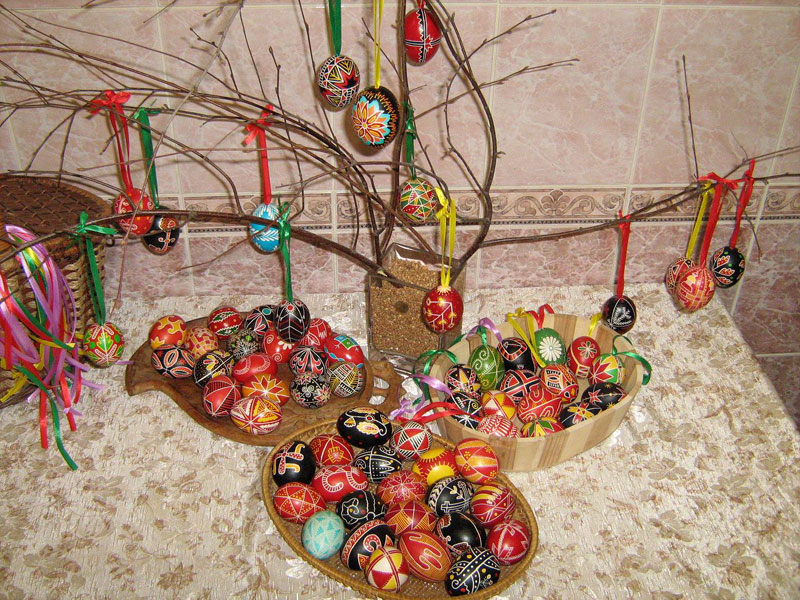
Pysanka was kept in huts as a talisman.
It was revered that it not only gives power to everything that awakens to the new: the earth, and man, and animals, and plants, but also brings beauty, health, and well-being.
Slavic pysanka is a tradition of painting bird eggs with paints and beeswax. Previously, they accompanied any person in the process of his entire life, from birth to death, protecting from hardship.
For most peoples, an egg is a sign of birth and life. The ornaments that were applied to the pysanka are by no means random. Absolutely any contains its own purpose. Drawings of Easter eggs, color combinations passed from pedigree to pedigree.
Easter eggs will not be allowed to be faked - they are all fragile and susceptible to the mood of the craftswoman, if you suddenly sit down to draw in confusion or discontent, they are able to fly out of the pens and shatter.
Now eggs are mostly painted only for Easter. Previously, they were written throughout the year: for bees, so that there was an abundance of honey in the hives, for fields, so that there was an excellent harvest. Women expecting babies decorated eggs with flowers or birds. This was strong amulet for a child. Her, painted with suns and beautiful butterflies, laid in cradles for babies, gave the kids to a bright, easy and carefree life - with "bloodworms". Jewelry painted with wishes for the young, she was considered the most an expensive gift at the wedding.
Protective amulets - an ornament on clothes
Amulet-embroidery
Clothing separates each person from the external environment. And whatever the method of protection, in accordance with the faith of our distant ancestors, it was necessary to strengthen it through the miraculous influence, repeatedly encrypted in the drawings of patterns, in the manifestations of the creations of art. Patterns of embroidery or weaving passed from pedigree to pedigree, brightening up ethnic garments. All of them were absolutely not disorderly.
Diversity in ornamentation arose only at the end of the 19th at the beginning of the 20th century in areas in which there was a fairly large influence of the metropolis. In the old days, in eras that even in our time are far from completely and completely investigated by us, the peasants portrayed a clear beautiful world, personal views about him, his own interdependence with him, his judgments about him in a conventional pictorial language. These were the original functions of the code, invented by the peoples and possessed magical properties.
It is possible that conditional images protected from hardship. Smoothly, this system turns into an artistic ornament, which, in addition to magical essence, received an aesthetic essence that is preserved even now, and makes one involuntarily admire this indescribable mysterious beauty. Thus, since ancient times, our adored ancestors have been sending us signals-symbols about their lives, about their worldview, about their relationship with the forces of flora and fauna. The decoding of these signals began to be investigated almost recently, and there are still quite a lot of fascinating and unusual things to be learned by people of future generations.
Patterns are complex in image, rich bright colors decorated ethnic clothes. At first it is difficult to understand their ancient secret meaning. Peaceful beauty geometric shapes does not reflect the system of the universe imagined by our forefathers, however, it is here that we see both the signs of the sun with bent fanciful ends, and the signs of a field like a rhombus with a dot in the center, and the signs of little men.
There were also all kinds of ornaments with simpler images of people, representatives of the plant and animal world, but their origins are in the most ancient Slavic traditions.
Charms for women
Charm wreath
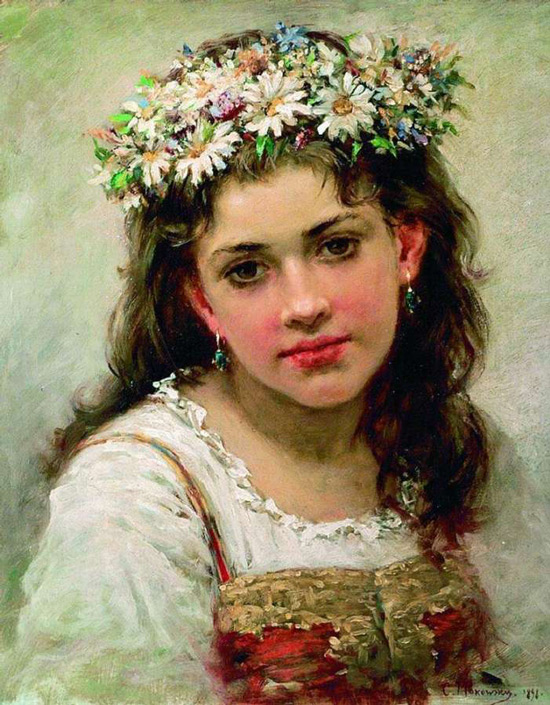
Girls from time immemorial have embellished their person with crowns of flowers. The gifts of the flora - fragile and short-lived personified the girlish color and sinlessness.
A wreath for girls was a symbol of girlish innocence, chastity, he protected her from the "evil look", from the "impure magical power".
AT summertime only fresh flowers were woven into wreaths: cornflowers, poppies, chamomile, marigolds. In the spring, sunny wreaths of dandelions looked dazzling.
Bright ribbons were attached to the wreaths, the colors of which indicated certain symbols:
- The light brown ribbon personified the Earth-nurse.
- The yellow symbolizes the sun.
- Green - beauty and youth.
- Blue and blue - water and sky.
- Orange ribbon - bread.
- Purple ribbon - human wisdom.
- A pink ribbon was woven for well-being.
- Ancestors were honored with a white ribbon.
There is a point of view to consider that the Little Russian crown with ribbons, which since the time of Adam has been considered a mixed component national attire, is nothing more than a bow to the "bright peace-loving sky" above the head of those who walk in it. This is an unusual amulet against everything nasty and fierce.
Wreaths were thrown on trees and attics, fearing God's wrath - lightning, placed directly under the initial sheaf in order to increase the subsequent harvest of crops, laid in nests for hens, in cradles of newborns, buried under clothes from witches, lowered into fields and gardens. The girls tried to wash themselves with water from a wet wreath in order to always be beautiful and healthy.
Our ancestors were clearly aware that it was their “head” that helped them understand the world. In this regard, hats were widely used to protect them from the evil eye and various intrigues of malicious people. There was a legend that the wreaths nailed on the doors guarantee the whole family health and well-being for the whole year.
Small wreaths, like a talisman, were given even to men who went to war.
With the idea of preparing amulets of love, for childbirth, for wealth and happiness, onion-garlic, ribbons, spikelets, delicacies, curls, special miraculous herbs were tied into wreaths.
A wreath - made of unnatural flowers, yarns - was often worn on the cap of the betrothed, protecting him from the evil eye.
In particular, the habit of entrusting the beloved (beloved) with a crown as a sign of matchmaking subsequently passed into the exchange of wedding rings - engagement. Previously, after the end of the wedding, the betrothed threw into the crowd of friends not a bouquet, but a personal crown. Who specifically catches - he will marry faster than the rest.
AT modern time a wreath is often used in wedding floristry to emphasize a romantic image.
Charms in Russia have existed for a long time, the most ancient of them have a history of millennia. The popularity of charms was very high - almost every house had a charm. In Russia they gave great importance magical possibilities different items - both self-made and natural formations. The Slavs had a unity with nature, almost lost in our time. They knew how to receive strength and energy from nature, communicate with animals and Gods.
The ancients believed that sacred symbols were presented to mankind higher beings, and each symbol contains divine knowledge about the universe. Moreover, each of the symbols has its own meaning, its own knowledge and its own magical potential.
Russian amulets and talismans and their meaning
The pectoral cross contains powerful protective forces
Amulets and talismans were an integral part of the culture and life of the Slavs. Many of them have survived to this day. For example, pectoral cross- one of the oldest Slavic amulets although many people don't even realize it.
The amulets of ancient Russia can be conditionally divided into verbal, subject and symbolic.
Subject amulets include various gizmos and objects made independently, bought or simply found. Moreover, it is worth noting that handmade items had greater potential and significance than purchased ones.

Verbal amulets and conspiracies have importance for a Russian person
Symbolic Russian amulets are images that can display objects of the real world, including Gods and animals, or contain a sacred drawing. Prayers and conspiracies are.
Amulets and talismans can be universal, that is, protect against any negativity, or they can be with one specific property, for example, protect against various diseases.
How to choose a Russian amulet
Before making or buying a charm, you need to clearly understand what kind of protection or help you would like to receive in life. You may not be able to resolve on your own problem situation, or do you have serious problems with health or you just vaguely feel some kind of threat from the outside world. Motives can be very different, you need to determine the most important for you.
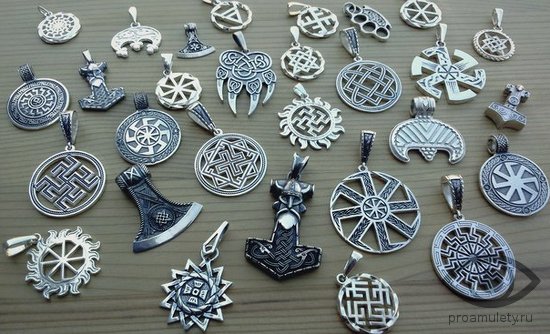
Your inner feelings will tell you in choosing a talisman
You can choose a suitable amulet for yourself, having familiarized yourself with its meaning and properties. Or, if you have a well-developed intuition, you just feel that this particular amulet is yours, then do not hesitate and buy or make it.
You can choose any material for the amulet. It can be glass, wood, fabric, stone and others. There is only one condition - you should not have negative feeling in relation to the material itself, and also the material should be in harmony with the character of the person for whom you are going to make the amulet.
Home amulets
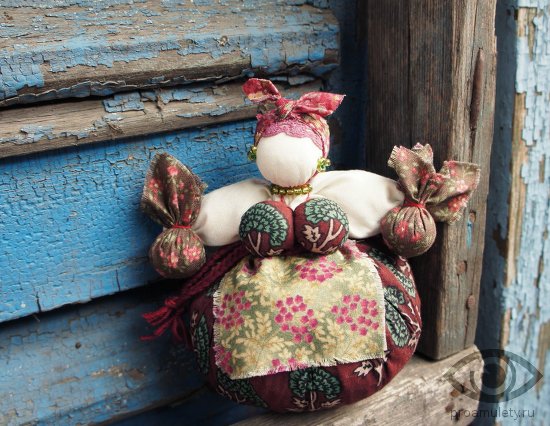
All handmade amulets are always made only from natural materials
In the homes of our ancestors, there was always a guardian, and often more than one. Protective items were very different - pads with dried herbs, and many others. One thing united them - they all had to be made of natural materials. Natural materials themselves are excellent defenders against ailments, problems and magical attacks.
The Slavs attached special importance to wormwood. Pillows and pupae were filled with it, or a wormwood broom was simply placed near the entrance. Dark forces are afraid of wormwood, and people with unclean thoughts will feel some kind of barrier and will not enter your house.
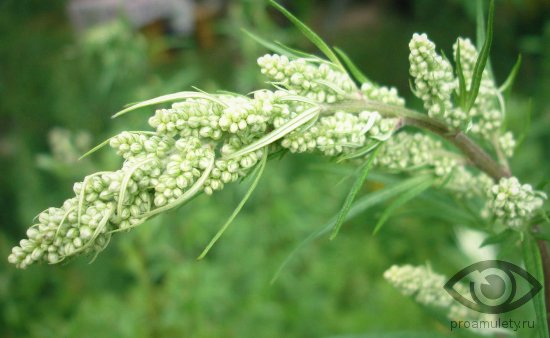
Wormwood has long been endowed mystical properties and often used in various ceremonies
Today, wormwood has not lost its magical power and significance. You can add a small bunch of wormwood to your entryway as a decorative element and this herb will protect your home from intruders as well as envy, evil eye or spoilage. A small doll with wormwood inside will reliably protect you on the road.
Another amulet known to every Russian person is this. The horseshoe has several protective properties, the manifestation of a particular property depends on how you position the horseshoe. To attract good luck, the horseshoe was placed with the ends up, and to protect the house from dark forces and deceitful people - ends down. Placed a horseshoe most often at the entrance to the house. If a horseshoe is decorated with wormwood branches, then its strength will increase.
Considerable fame today has such a charm as a bell. Usually it was made by hand and also placed near the entrance or just on the front door. The bell symbolizes well-being, and its ringing has a beneficial effect on the energy in the house and drives out evil.
Russian amulets for children
Magic items accompanied the Russian people throughout their lives. And mothers sometimes cooked even before the birth of the child. Basically, self-sewn pupae served as such amulets. The doll was placed in the crib, she protected the baby from the evil eye and at the same time warmed him.

The custom of putting a cross on a child originated long before the baptism of Russia
A newborn baby immediately received another of his personal amulets - a cross. The cross was worn to the child so that he always had a protective object with him. It is interesting to note that s. The Slavs believed that the cross has magic power, no less than that of solar symbols.
It has long been believed that small children are especially susceptible to the influence of dark forces, and, of course, they tried to protect the child as much as possible. One of the defenses was diaper dolls. They were made before birth, and from the first days of life, diapers were continuously next to the child for several months. Then they were removed and reused only when the child fell ill. Swaddling dolls protected the baby from any evil.
After seven years, the child received other amulets. The boys were put in their pocket some small pointed thing, and the girls were pinned with a pin with wrong side dresses.
Charms for the newlyweds
For the ancient Slavs, the family was the most important vital value. Communication between spouses, as well as blood relations revered as something unshakable. There were talismans and amulets that were presented as wedding gift, the main meaning of these items was to protect the new marriage from quarrels and trouble.
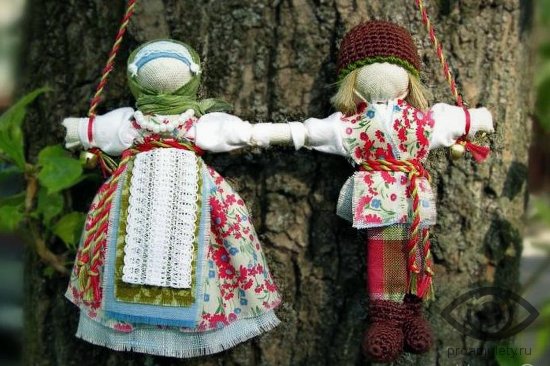
One of wedding customs was a gift to the newlyweds - a doll-amulet Lovebirds
The mother of the bride usually prepared a traditional talisman gift in advance -. These two dolls had one common hand, symbolizing life together in happiness and prosperity. Lovebird dolls were given to the bride and groom at the very beginning wedding ceremony, and then placed in the house of the newlyweds as a talisman.
Another wedding gift-amulet was a needle without an eye. For the bride, such needles were attached to the hem wedding dress, and the groom - on the belt. It was required to wear needles for forty days, it was believed that it was during this period new family most prone to envy and dark attacks.
In Ancient Russia, people believed in the power of amulets, relying on their protection from ailments, enemies and other misfortunes. Through their amulets, they drew the energy of nature and the Sun, never tired of thanking the Gods, who generously endowed the Russian people with unique Slavic magical symbols. All of them are carriers of information about the structure of our universe.
At the heart of Russian amulets lies Slavic symbols associated with the Sun, such symbols are called Solar. Each of them has its own name, they have a specific power and carry a certain semantic load. The most common symbol in Russia was the Swastika, endowed with a multifaceted meaning and various options titles. She was also called the symbol of "Light", the symbol of "Primary Fire" or "Life", " divine symbol". Patterns from these symbols were used to decorate household utensils, dwellings, and clothing. AT different times in Solar Russia, this symbolism could be seen on banknotes.
The history of the culture of Russia throughout its existence was based on folk beliefs which, with their roots, have grown deep into the past, and keep the memory of our ancient ancestors. In those distant times, they already sought to comprehend the secrets and subtleties of the structure of the universe. First of all, they needed this knowledge in order to protect themselves and loved ones from possible danger. Culture has changed over the centuries, beliefs and customs have changed, but the memory of the ancestors was not erased even after the Baptism of Russia. Loyal, wise and tolerant Orthodox Church did not destroy the traditional folk worldview, during the entire period of existence, the Russian people used amulets and talismans bequeathed to them by their ancestors.
Features of the folk Russian amulet
A Russian person is devoted to his family and true to his land, therefore Russian amulets, like talismans, are mostly associated with real things familiar to each of us since childhood. Among these, you can find ordinary spoons, bells, miniature hatchets, a poker, a broom, bast shoes, a horseshoe, etc. They were widely used not only in Everyday life Russian people, but also in folk rituals. Protect for yourself the people made with my own hands, hoping for their protection from predatory animals, natural disasters, the "evil eye" and diseases.
Russian amulet for home
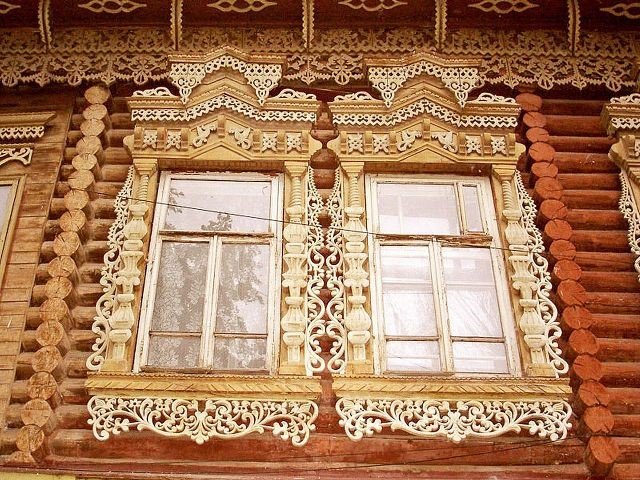
A home for a Russian person, in terms of its significance and holiness, after the church and Orthodox churches is in second place. Even going to long way, he always took a charm on his way, created by his own hands, as a reminder of home, family and native land. The earth also acts as a kind of amulet for the house, which had to be built correctly, since the fate of the whole family depended on it.
In Russia, houses have always been built in favorable energy zones and traditionally adhere to certain rules when choosing a piece of land:
- They did not build houses in places where lightning struck.
- Areas that had previously been massively abandoned by people as a result of an epidemic, pestilence, war, and natural disasters were considered unfavorable.
- Never built a house in a place where human remains were found.
- The places where the cart overturned or the shafts broke were considered the mark of the “unclean”, they were bypassed.
According to ancient traditions, a Slav built his house with his hands, by analogy with the model of our Universe, in the center of which was a Russian stove - a source of heat, food, light, perceived as a symbol of the Sun.
cult of the house and family hearth in Russia has always been the main thing. Each element of the construction of the house was a certain symbol, as well as the decoration of the house.
Its main symbols are Russian folk amulets at home, they are all listed in the table below:
| Name | Symbol (association) |
Functions |
| Bake | Planet Earth. The stove was painted with special protective symbols. | Source of heat, fire, life. |
| red corner(home iconostasis) | Planet Sun; God. | Divine protection, patronage, healing. |
| Walls | They were decorated with various symbolic wood carvings. | Physical and energy protection habitats |
| Roof and openings | Decorated with symbolic carvings. | They did not allow entry into the house of physical negative factors, as well as from all evil spirits and evil misfortunes. |
| Entrance door | Central amulet (various amulets were placed above the door; the door itself was coated with red clay along the contour; curtains woven with patterns with special symbols were hung in the doorway). |
Home and family protection at the level of: Physical (negative weather, enemies, robbers); Mental (evil spirits, illnesses, troubles). |
| threshold/porch | The key element of the house was endowed with the greatest protective power (everything was important - from its shape to decoration, including amulets that were placed under the threshold to enhance its magical properties). | In the pagan and Christian faith, he was the main protection of the house and kind of man, the keeper of the family hearth. The threshold was carefully guarded, because through it you can bring into the house, both a good and a bad deed. |
| Vane | Often made in the form of a rooster or horse | Charms that warn the owners of the house about the danger and scare away evil spirits. |
The carving acted not only as an ornament, its patterns were carefully thought out and corresponded to the old Russian protective symbols. Carvings were used to decorate door and window openings, the edges of the roof, and the porch.
The threshold and porch in a Russian hut have always been endowed with the most powerful amulets and additionally guarded by the owner himself. Through the threshold (or porch), you can send a lot of negativity, both to the owner of the house, and to all members of his family, to the whole family.
Lots of folk signs associated with the threshold, for example, it is undesirable to just stand on the threshold, smoke or talk, pass things or greet through the threshold. To protect the home and family across the threshold, both Christian and pagan amulets, symbols, conspiracies and prayers were used (and are relevant today).
Of particular importance is the blower in the Russian stove. This place was considered the gate through which the Unclean One could enter the house. While the furnace was burning or smoldering, the blower was not closed so as not to burn out from carbon monoxide, but as soon as the last heat in the furnace was extinguished, the blower was immediately closed.
Charms to protect the yard
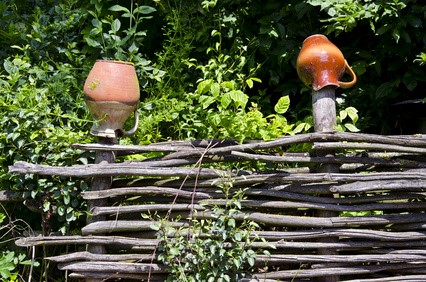
The courtyard area is a part of the personal space of each family, limited by a special fence. In the old days, the fence of a house or plot was built in the form of:
- wattle (from a vine or brushwood), in the form of a picket fence (from low wooden slats);
- board fence;
- a powerful timber palisade several meters high.
Whatever material the fence was built from, for many centuries the courtyard was guarded and protected with the help of traditional amulets. These were the simplest everyday things, in the powerful protective energy of which our contemporaries also believe. As amulets of the yard were used various items, they were all considered magical protective symbols.
Glechiki, krynki, pots
Inverted, they were planted on the highest rail of the fence, wattle. 
Since this utensil was usually made of natural material– clay, she was very sensitive to negative energy.
It was believed that a broken or cracked glech on the fence indicates a negative message to the owner of the house or his entire family. In this case, they said that the glechik took on the “bad thing”, it was not customary to take it with bare hands. Usually it was removed with special tongs and thrown away from the house, and a whole pot was immediately hung in its place.
Old (woven) bast shoes, worn shoes, felt boots
A shoe (boots or bast shoes) is an old Russian amulet with many-valued symbols. For example, having met the Unclean, it was customary to throw at him with your worn-out bast shoes and be sure to hit the target, if you didn’t hit, expect trouble or trouble.
A pair of red shoes given by a guy to a girl testified to his sincere love to her, a similar gift from her parents served as a talisman so that her daughter would not go astray from the “red” (right) path.
There was a tradition of throwing bast shoes at their rivals. If the bast shoe reached the goal, it was believed that by this action the girl dared the rival from her lover, and at the same time removed the love spell that she could do on her boyfriend.
A pair of shoes attached to the porch or threshold symbolized the strength and prosperity of the owner of the house, happy family. To scare away all evil spirits and enemies, shoes or bast shoes were hung on a fence or on a post at the gate.
If an unlucky child grew up in a family, he was forced to put on the old bast shoes of that family member who was considered positive and hardworking, with this action of a child who got out of hand, they tried to return to the true path. 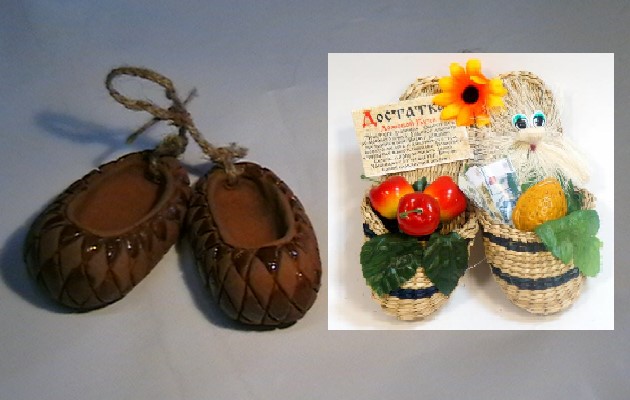
The theme of shoes is also found in many beliefs and divination. For example, there was a long-standing custom of divination for the groom. To do this, the girl, standing in the courtyard with her back to the gate, threw a bast shoe through them into the street. Then she watched how the bast shoe lay down - its toe, as a rule, indicated the direction from where the groom's arrival should be expected.
If a person wanted to travel, but could not decide where exactly to go, it was also customary to throw a bast shoe over the gate. In the direction where the sock pointed, the man set off.
A pair of symbolic shoes were given to young people for a wedding, so that they would live happily together for as long as possible.
In addition to its decorative function, the horseshoe in Russian culture and traditions has always been used as an effective amulet / amulet. In many countries, it is a symbol of happiness, having under it deep meaning rooted in a long history.
Made of iron, forged on fire by a blacksmith, purified by fire, 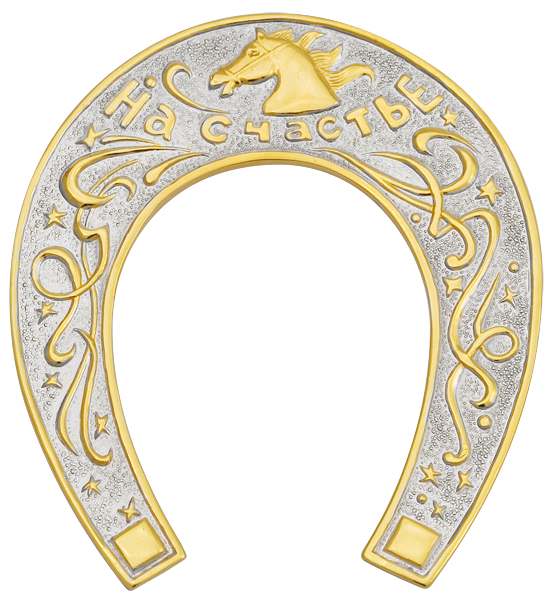 resembling a young month in shape (also a symbolic element), a horseshoe was once an expensive pleasure. Finding it for a simple poor peasant was considered happiness, since expensive iron appeared in the house, which could be sold expensively or reforged into nails, a scraper, a knife or other required item. Later, when iron was no longer such a rare thing, the tradition of saving the found horseshoe “for good luck” was preserved.
resembling a young month in shape (also a symbolic element), a horseshoe was once an expensive pleasure. Finding it for a simple poor peasant was considered happiness, since expensive iron appeared in the house, which could be sold expensively or reforged into nails, a scraper, a knife or other required item. Later, when iron was no longer such a rare thing, the tradition of saving the found horseshoe “for good luck” was preserved.
In every European country, you can find a legend about a horseshoe; in Christian culture, the legend itself and the tradition of protecting a found horseshoe are most likely borrowed from the ancient pagan culture Celts. They believed that a horseshoe attached over front door, will protect their home from the invasion of otherworldly forces.
Nowadays, the horseshoe is endowed with multiple symbols, which can be found in the table below:
| Location | Function | The value of the amulet |
| "Horns" down above the door to the house, on the gate, on the pillars of the central gate | Protective (from the evil eye, damage, evil message and ill-wishers) | The guest, having passed through the gate, “lost” his bad thoughts and was disarmed if he came with bad intentions |
| "Horns" up above the door to the house, on the gate, on the pillars of the central gate. | Talisman of wealth, happiness and prosperity | Brings good luck, material and financial well-being |
| On the door (from its inner side with “horns” up) | Protective bioenergetic | Aligns energy flows, reducing the strength of geopathogenic zones in the house |
| Inside the car | Protective | Prevents accidents, vehicle breakdowns and various unpleasant road incidents |
| On the windowsill (on the first moonlit night, "horns" into the room) | Talisman of wealth / good luck, money talisman | Helps increase financial situation, attracting money and rapid financial growth |
| In the ground near the wall of the house (bury from the northwest side) | good luck charm | Brings good luck in business, support in any endeavors |
Fishnet
They threw it on top of a fence, palisade or wattle fence, believing that it would get tangled in it. 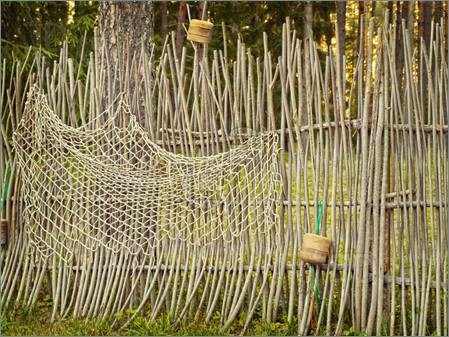 Unclean and will not be able to enter the house. It was also assumed that bad words and thoughts of ill-wishers could not pass through this network.
Unclean and will not be able to enter the house. It was also assumed that bad words and thoughts of ill-wishers could not pass through this network.
Toads, mice and other reptiles entangled in the net testified that one of the ill-wishers was taking negative magical actions against the owner of the house and his family.
Broom
Exposed at the threshold, the broom frightened off evil spirits, drove away ill-wishers from the house. It was believed that if, following an unpleasant guest leaving your home, sweep the path in his footsteps with a broom, this person will never appear in your house again. It should be noted that the broom was not only a shore, through it considerable harm could be done to the family, so in some families they preferred to hide it from prying hands and eyes. Usually the head of the family made a broom-amulet with his own hands.
For prosperity in the house, it was customary to put a broom in the kitchen “on the handle” with a broom up. Nowadays, for this purpose, a small decorative broom is often used, on which gifts are fixed - several grains of various cereals, corn grains, real coins, 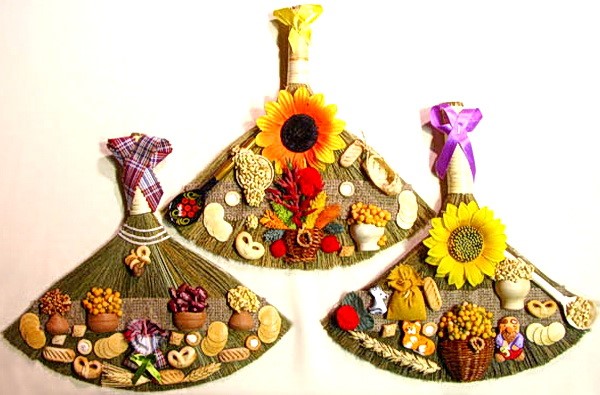 flowers yellow color(as a symbol of the Sun, gold) and so on. Left in the kitchen as a decoration, such a decorative amulet brings material stability and prosperity to the house.
flowers yellow color(as a symbol of the Sun, gold) and so on. Left in the kitchen as a decoration, such a decorative amulet brings material stability and prosperity to the house.
It was considered wrong to touch a broom in a strange house with your hands; such a guest could be suspected of hostility and more allowed into the house.
Panel-amulet
Such panels were specially made in each family, so they were all unique and not similar friend on a friend. Each hostess made her own panel, decorating it with the symbolism that was most necessary to improve the life of her family.
With the help of special symbols of patterns, such panels protected the house from unkind people, brought good luck, health, patrons for the family, contributed to mutual understanding, love and care for each other of all households.
Embroidery
Embroidered symbols could be seen not only on clothes, but also on bed linen, towels, towels, tablecloths, curtains, shoes and head ornaments. A young girl, getting married, had to have all these things in her dowry, sewn and embroidered by her hands.
Girls began to be taught to needlework from early age. The more the girl had a dowry, prepared by her, the more hardworking she was considered and was more desirable in the groom's house.
In Russia, the bag has always been considered a symbol of the preservation of wealth. This symbolism originates from ancient times, when social inequality was the norm, as a result of which beggars wandered around Russia with outstretched hands. Behind them was a knapsack ( homemade bag) with all their simple belongings.
For every beggar, such a knapsack was a real treasure. At the same time, rich people also kept their gold and jewelry in bags, but they were made of expensive fabric and embroidered with gold / silver thread, embroidered with stones or embroidered with patterns. 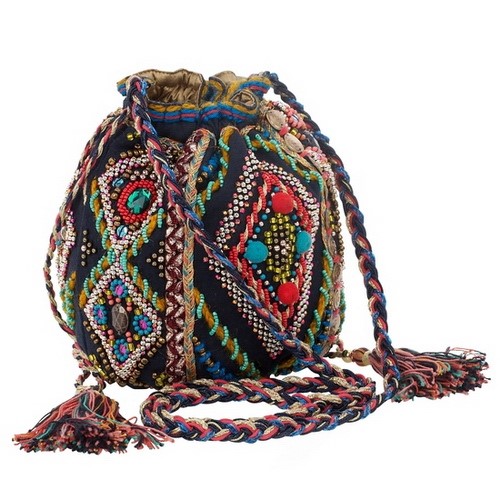
Nowadays, it is customary to place a symbolic bag in the kitchen or in the money zone of the house, decorating it with your own embroidered patterns, which necessarily include some key magic symbols. It can be decorated with various symbols, depending on the result that should be obtained - the multiplication of wealth, the preservation of existing wealth, etc. Inside the bag they put coins for wealth, magical dry herbs for protection and other items that correspond to the desire of the owner of the house. This amulet should not be touched by strangers.
Painting on wood, plaster, metal
Painting with colorful symbolic patterns of gates, walls of the house (outside / inside), door and window openings, shops (at the gate and in the yard), stove, barn, barn and cart was also a talisman.
Especially popular was the theme of solar signs, attracting warmth, joy, life, health and happiness into the house.
Amulet fruitful
This Russian amulet symbolized generous gifts nature, was used as a talisman for the welfare of the family and was not bad decorative element in home decor. As a "rural" decor, it is still found today in dwellings, the interior of which is made in the "country" style. Often, for this purpose, a decorative broom-amulet, decorated with special symbols, is also used. 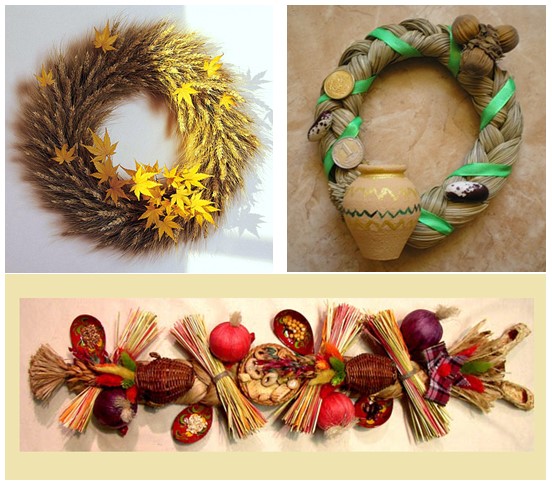
For its manufacture, nuts, dried flowers, garlic knitting, rose hips, spikelets of wheat, beans, a small pumpkin, bright ribbons are usually used (they tie the whole composition with them). A braid should be braided from colored ribbons, with its colors it symbolizes a joyful and happy life, long and thick - longevity. The lighter of the above symbolic elements are woven into it, the heavier ones can be fixed with glue or sewn on, fixed to the ribbons with threads.
Each such element corresponds to certain symbols, which differ in their characteristic magical properties:
| Element | Value in the amulet |
| Broom | Pure base |
| Spit | Longevity |
| Prosperity, abundance, wealth | |
| A spoon | Prosperity |
| Onion / hot pepper / garlic / | Protects from evil spirits |
| Cereals and flour products | Prosperity, hospitality and good location of the owner of the house (tradition to meet guests with a loaf / bread and salt) |
| Cone, coins | Success in business, financial well-being, wealth |
| Sunflower seeds | Symbolizes the children in the family |
| Beans/peas | Friendship, mutual assistance, peacefulness |
| Dried flowers (in a bouquet) | Harmony, beauty, protection from evil spirits and "bad" people |
| cereals | La, and the well-being of family relationships |
| Female and male figurines | Inseparability of marital/family ties |
| Corn | Health of children in the family |
| small house | Happy family, cozy home |
| Jug | Healthy family, family well-being, prosperity |
| Immortelle | long and happy life |
| Bay leaf | Success in business, fame, honor of others, respect in the family |
| Poppy | Fulfillment of secret desires |
There is a huge variety of folk Russian charms, for the manufacture of which a variety of symbolic elements are used. The table above lists only the main and fairly common characters.
The Russian people have always carefully and respectfully treated the gifts of mother nature, believed in the existence of her mythical creatures inhabiting all four elements - fire, water, earth and air. There are many legends and fairy tales about kikimors, water, goblin, brownies and other evil spirits in Russian culture. attitude towards these natural creatures the Russian person is twofold.
He tried to be friends with some of them, to appease some, to pay off some of them, and some of them should have been bypassed so as not to anger with his presence on their territory. Some representatives of the Unclean were often taken as assistants to solve various problems. life tasks and domestic problems. At the same time, Russian people have always made amulets to protect themselves and their homes from evil spirits; they used long-known folk symbols to create them. A curious character is a brownie, it was believed that this creature lives in every house.
Being the soul of the house, its talisman and amulet, Brownie patronized the people living in it. Woe was to the owner who did not like him, Domovoy tried in every way to expel him from the house, could involve him in this process and 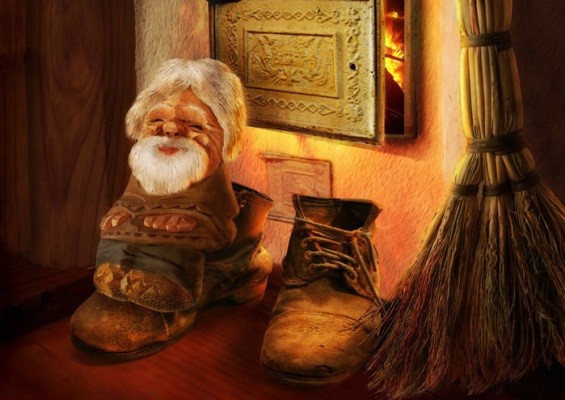 other creatures from evil spirits. He demanded respect for himself, it always depended on whether he would consider the tenants of the house as his friends and whether this family would live in prosperity and tranquility. It is noteworthy that with the hands of an objectionable owner, he could cause great trouble in the house.
other creatures from evil spirits. He demanded respect for himself, it always depended on whether he would consider the tenants of the house as his friends and whether this family would live in prosperity and tranquility. It is noteworthy that with the hands of an objectionable owner, he could cause great trouble in the house.
Sometimes the Brownie got so used to the head of the family that when the family moved to a new place of residence, he tried to move with people, hiding in some household item. Most often, the person himself offered Domovushka to move with him, offering him a broom, a bread shovel or a broom with the words:
Neighbor-Domovushka, here's a noble sleigh for you, go to new house together with us!
The brownie sleeps during the day, and wakes up at night and walks around the house, examining whether everything is in order. He was always given a specific corner in the house, where the owner forbade all members of the household to go, so as not to anger the Brownie with his actions. In this place it was impossible for children to play, put any things, make noise, sit, this place belonged to the Brownie. In every house, Domovushka could occupy different places, his favorite place it was necessary to find, as a rule, it was the warmest, dryest and quietest corner. Sometimes he himself willingly prompted and indicated his presence.
Domovoy has fun noisily - he knocks at night, confuses the mane of horses, hides small things necessary for the owner. To return the thing he hid (a thing that you cannot find in the place where you left it the day before), you should throw a coin into the room with the words:
Neighbor-Housewife, here's a coin for you to play, and give me mine / mine (name of the thing).
After that, you need to leave the room for a couple of minutes and close the door. After this time you will find lost thing in the place where they left it and looked at it several times before, but did not see it.
Nowadays, the Domovenka theme is very popular - it is a magnificent element of apartment decor and at the same time an effective and powerful amulet. Each Domovushka must contain 12 symbolic items. They are symbols such as dried berries, dough products, dried flowers and other symbols. Its basis can be any, but more often a wooden spoon, a wreath, a horseshoe, a bag or a broom are used for this.
Brownie is the spirit of the house, it is a mischievous and mischievous creature, but always kind and ready to help the owner manage the household, protect the house and family. Often Domovushka warned the head of the family about the impending disaster. It is necessary to make friends with this creature and not forget about it, leave food, give some things, throwing them into its corner.
If you cannot detect its presence in your home, make it yourself, this is the best and most powerful amulet for your home.
Charms to protect the child

At a time when medicine was not yet so developed as to save a person’s life from an elementary cold, he relied only on the mercy of God and magical protection amulets and talismans.
The very first and strongest protective amulet for a child, a pectoral cross was considered. They tried to put it on a child even in the process of childbirth in order to protect the still unbaptized baby from evil forces, since the Guardian Angel appears in children only at the age of one year, and according to some beliefs, at the time of baptism.
The child received his next amulet from Mother Nature herself - this was his first milk tooth, which during the change of teeth should be hidden and kept all his life as an amulet or talisman / amulet. Until the moment when the child was toothless, he was considered easy prey evil spirits, so it was not customary to leave him alone for a single minute.
important and a powerful amulet a cradle served for him - a kind of hanging cradle, made of bast or made of wicker, of wood or wooden slats, with a canopy sewn from his mother's skirt.
Inside such a bulge, under a children's mattress, they hid two cross-cut knives or scissors (opened in the form of a cross). There they also put a handwritten version of the prayer “Holy relics” from the 90th psalm or, to choose from, a prayer (also written by hand) to the “Honest Cross”.
From evil spirits penetrating the house at night, the baby was protected with the help of amulets. For example, a broom for the night "on the handle" on the threshold to the baby's room, an alternative was an ax, also installed at night on the threshold with the blade up.
There was a custom to specially smear the child's face with soot from the oven, so that he would not be recognized and carried away by evil spirits. Soot was also smeared on the skin in the projection of the joints and bones of the child, forming a sacred cross. 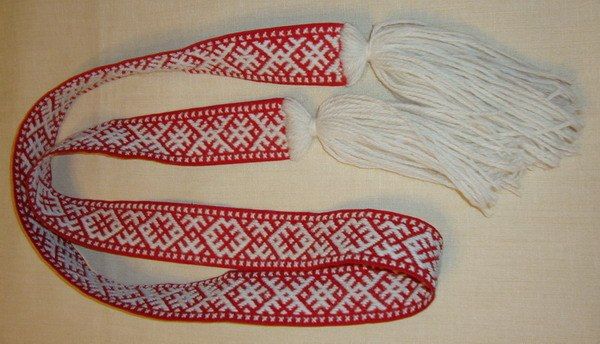
A belt embroidered with protective symbols was put on the child when he reached the age of one year. It was a beautiful family ritual, to which neighbors and friends were not invited, but only the godparents of the baby. He was solemnly girded with this belt, which was supposed to strengthen his protection outside the house.
The baby's mother, with her caring hands, sewed the belt in advance and embroidered it with a protective pattern, the symbols of which were always passed on to the new generation of the family. In the event of death or sudden death the baby, this belt, intended only for him, was buried with him.
At the age of seven, it was customary for a child to pin an ordinary pin to his clothes (head down), but more often it was worn by girls.
As a talisman, the boys had to carry some sharp object in their pocket - a nail, a planing knife, an awl handed to him by the hands of their father.
For many centuries, Russian people surrounded their home, themselves and their loved ones with amulets. Nowadays, we use the same protective symbols, however, we often wear them in the form of pendants and other jewelry. Today, along with man-made amulets, you can purchase a ready-made Russian amulet or jewel with the corresponding symbols. Many amulets have lost their relevance over time, some have transformed and adopted new form, but the belief in their magical power did not disappear from the Russian people.
The culture of Ancient Russia is very interesting and informative. Each of us simply needs to know how our ancestors lived and what they believed. Amulets occupied a special place in the above culture - various items, which protected the owner from troubles and the evil eye. Amulets were of various types, not necessarily difficult to manufacture. Household things, specially made amulets, trophies were considered such an object. Amulets were made from clay, metal, wood and other materials that were available at that time. Embroidery was considered the strongest amulet, as well as painting, which could be found on dishes and other household items.
The pagan culture was gradually replaced by Christianity. Despite this, the ancient Russians continued to believe in their gods and keep old amulets in their homes. Some of them have survived to this day and have practically not lost their significance. Each item in Ancient Russia had its own sacred meaning, could protect a person from a certain misfortune. In this article, we will consider the most common and popular ancient Russian amulets that are available. modern man. Moreover, we encounter some of them in everyday life, while others we can make ourselves, if desired.
solar circles
The most common ancient Russian amulets were those that guarded the dwelling. The house for the ancient Russian was a holy place, which he tried to protect from evil spirits and misfortune. Amulets were located directly in the house, under the threshold, in the doorway, in the yard. By the way, home painted utensils served not for beauty, but also for protection. In addition, in order to protect their home, its facades were decorated with carvings, which were most often applied to shutters, window and door openings.
The most ancient protective patterns symbolized the three elements: Earth, Water and Fire. The sign of the first element was a rhombus, divided into 4 equal parts, in the center of which there were points. Water was depicted as wavy lines. The oblique cross was the symbol of fire.

The above-described symbolism of the Russians was located in those places through which evil spirits could get into the hut - around windows, doors, on the stove and on the chimney. Often, on such passages, a symbol of the sun was drawn, which was a 6-ray or 8-ray star enclosed in a circle. On the facade, the symbol described above was often depicted in three positions: morning, noon and evening. Thunder symbolism was placed next to the solar symbols, which was supposed to protect the house from lightning strikes. The thunder symbol was a circle divided into 6 equal sectors. Also, the collection of protective signs was supplemented by the symbol of Rarog - watercress, enclosed in a circle, which denoted the harmony of fire: heavenly and earthly.
How was the horseshoe used?
The Russians associated the image of a horse with a horseshoe - a magical and sacred animal for them. It was believed that a horse (animal, figurine or pattern) displays a celestial chariot driven by Dazhbog. The heavenly chariot, in turn, symbolized the sun.
Children's swings were often decorated with carved horses and figurines of horses. It was believed that if a child plays on such a swing, he will have a successful marriage and a happy life in the future. This was especially true for girls who were to become wives and guardians of their home. The joint swing on the swing of a girl and a guy was considered a blessing of their union. Such a ritual brought them happiness and mutual understanding.

Also, in order to attract happiness to the family, it was customary in Ancient Russia to hang old pots and wicker worn bast shoes on the fence. Horseshoes, in turn, were kept mainly on the gates. They were considered the most powerful talisman, symbolizing the month (Moon). The strength of the horseshoe was given by the sacred fire with which it was made.
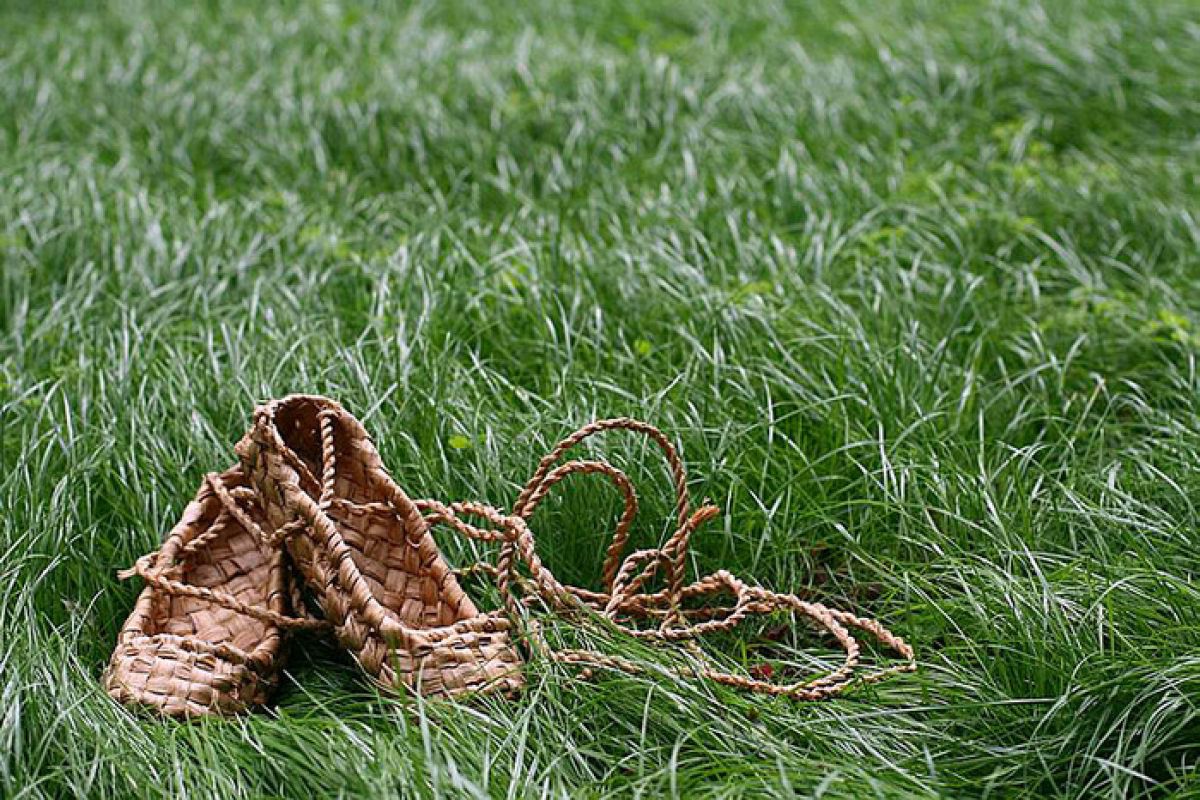
A horseshoe was sometimes placed in the chimney so that it would prevent evil spirits from entering the house through it. It was believed that if this talisman is attached to a bed or placed under it, then the person who sleeps on it will not have nightmares.
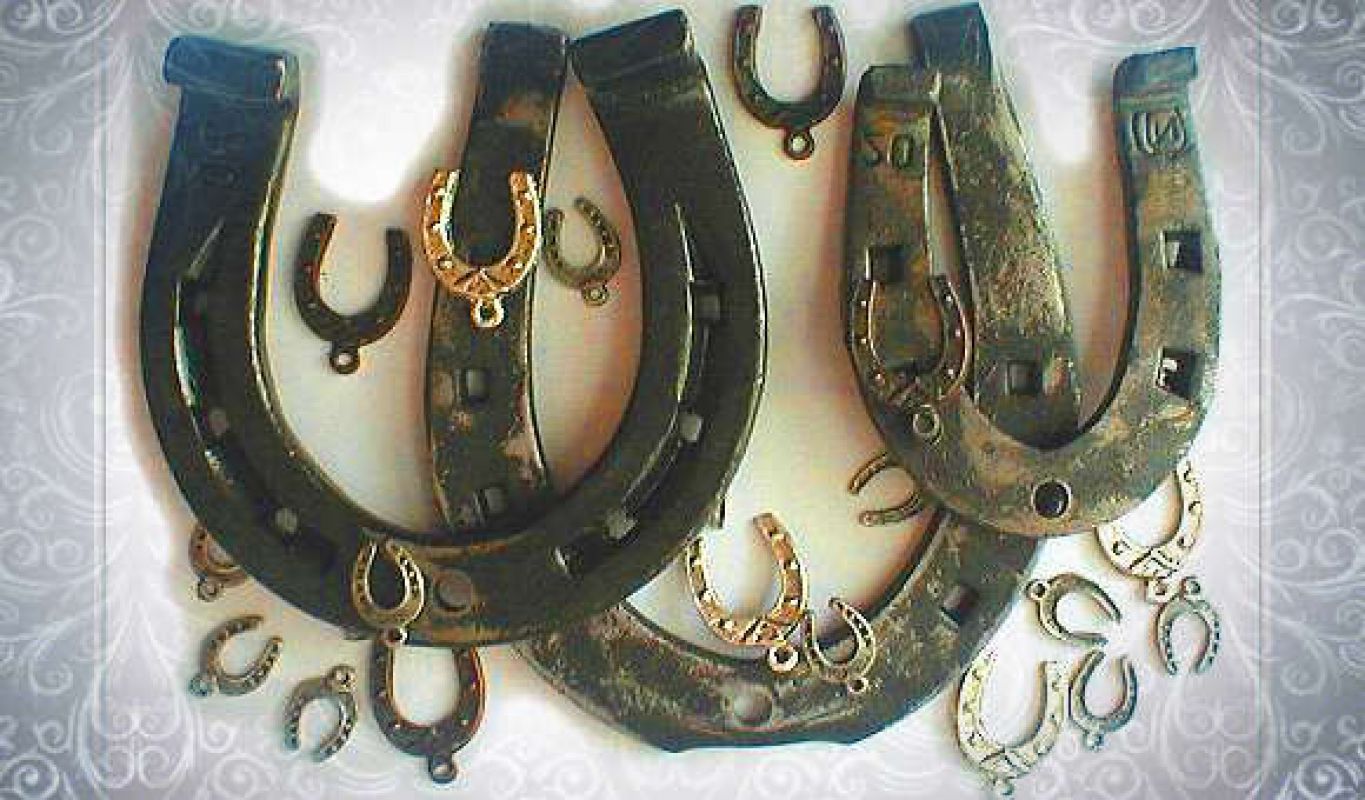
To this day, the custom has survived to hang a horseshoe over the door, but we - modern people we're doing it wrong. The horseshoe must be placed with the "horns" up. Otherwise, she will not be able to keep happiness, she will “spill” it.
Home amulets in Ancient Russia
AT home interior almost all objects were covered with protective symbols. This was especially true of the stove, kitchen utensils, working tools, beds. The doors had special meaning they served as a portal between real worlds: internal and external. Nettle bundles were placed near the threshold of the door, symbols were cut out on the jamb, fragments of a scythe or a knife were stuck into the gap on the jamb or threshold. In the most ancient times, the ashes of ancestors were buried under the threshold of the house, which, after death, protected the rest of the household. The rule has survived to this day that it is impossible to sweep garbage through the threshold of the house, as this will drive away the defenders of the house. In addition, the Russians believed that nothing could be passed through the threshold, as well as talking with a person. Guests were always met at the threshold, and then let into the house in front of them.

The stove was the main household item. There is even an opinion that the houses were built around the stove, which is logical, since it heated the premises, served for cooking, and had a special sacred meaning. The stove was painted with a special ornament, in which the symbols of the god Svarog were present - a square (a symbol of a family hearth), crossed spindles (symbols of fire) and much more. The stove was always kept clean, next to it they tried not to quarrel and not offend others.
When bread was cooked in the oven, strangers were not allowed into the house, as it was believed that this would attract trouble. It was necessary to clean the domestic premises from the doors to the stove. A heated stove could not be thrown without contents - firewood was always placed in it to dry, as well as water so that it was heated.
Near the stove there were special items that they tried to appease the brownie. Such items were: a broom, bast shoes and a bread shovel. Then the brownie understood that the house would always be clean, satisfying and rich.
Diagonally from the above-described piece of furniture, a pokutya was placed - a “red corner”, in which spikelets were stored before the advent of Christianity. Every year, grains from them were added to wheat, which was sown in the field in the spring. It was believed that the headboards of all beds in the house should be directed to the "red corner".

Old Russian embroidery
Embroidery decorated not only clothes, but also bed sheets, decorative home textiles, towels, tablecloths and various ritual paraphernalia. The main purpose of embroidery was protection from damage and evil. Creating such a complex and at the same time beautiful amulet, the craftswomen observed certain rules. For example, on reverse side embroidery should not have knots. If they were present, then needlework did not acquire magical power.
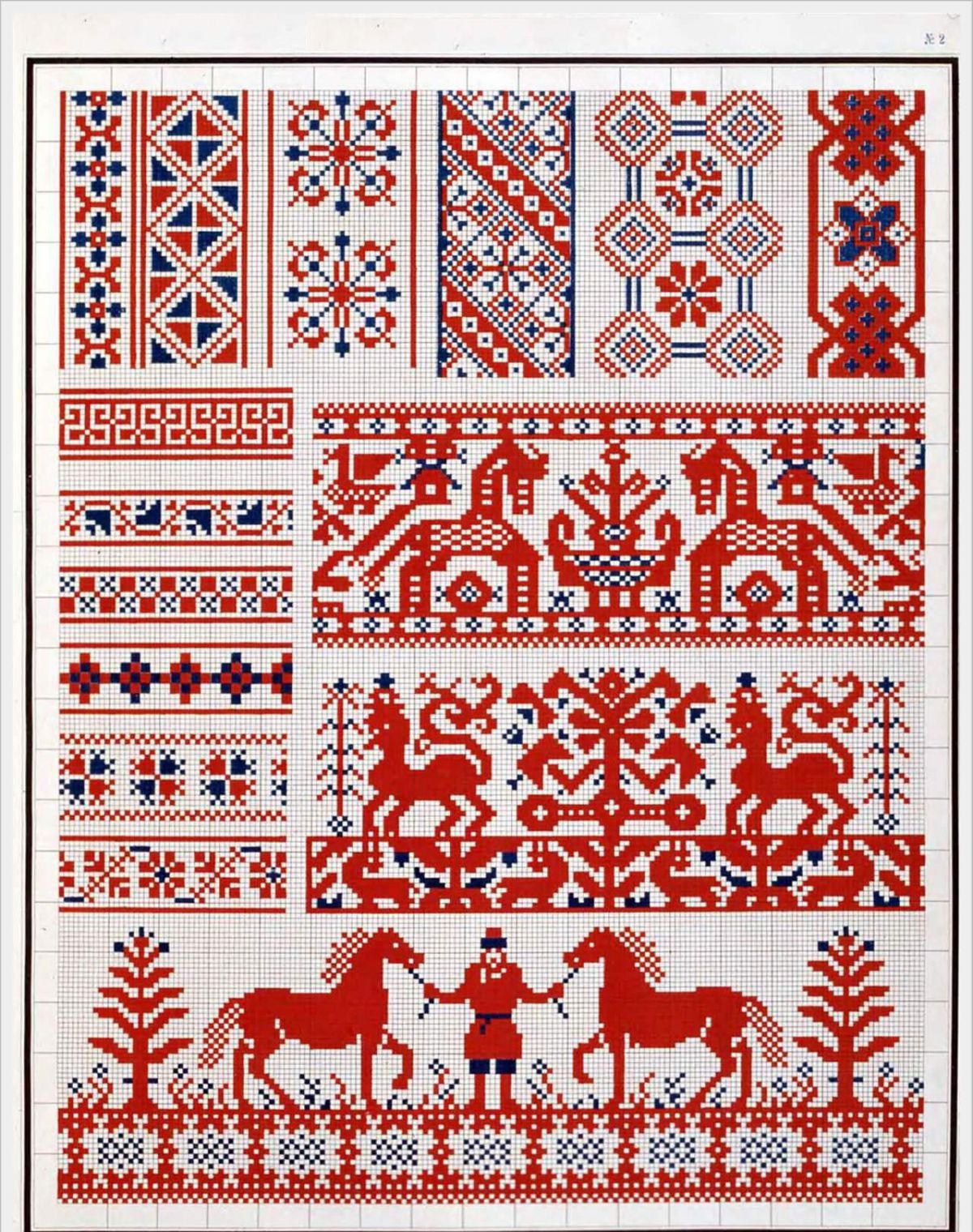
Embroidery as a talisman was never done for oneself. For it to really have protective magical properties, it had to be made close person(most often mother or wife) who sincerely desires happiness. Most often, Old Russian craftswomen embroidered various symbols of the sun. In addition, the symbolism of a tree was present in the embroidery - Christmas trees (a symbol of life and longevity), stars (a symbol of reason), flowers (a symbol of youth and beauty), circles and squares (a symbol of fertility).
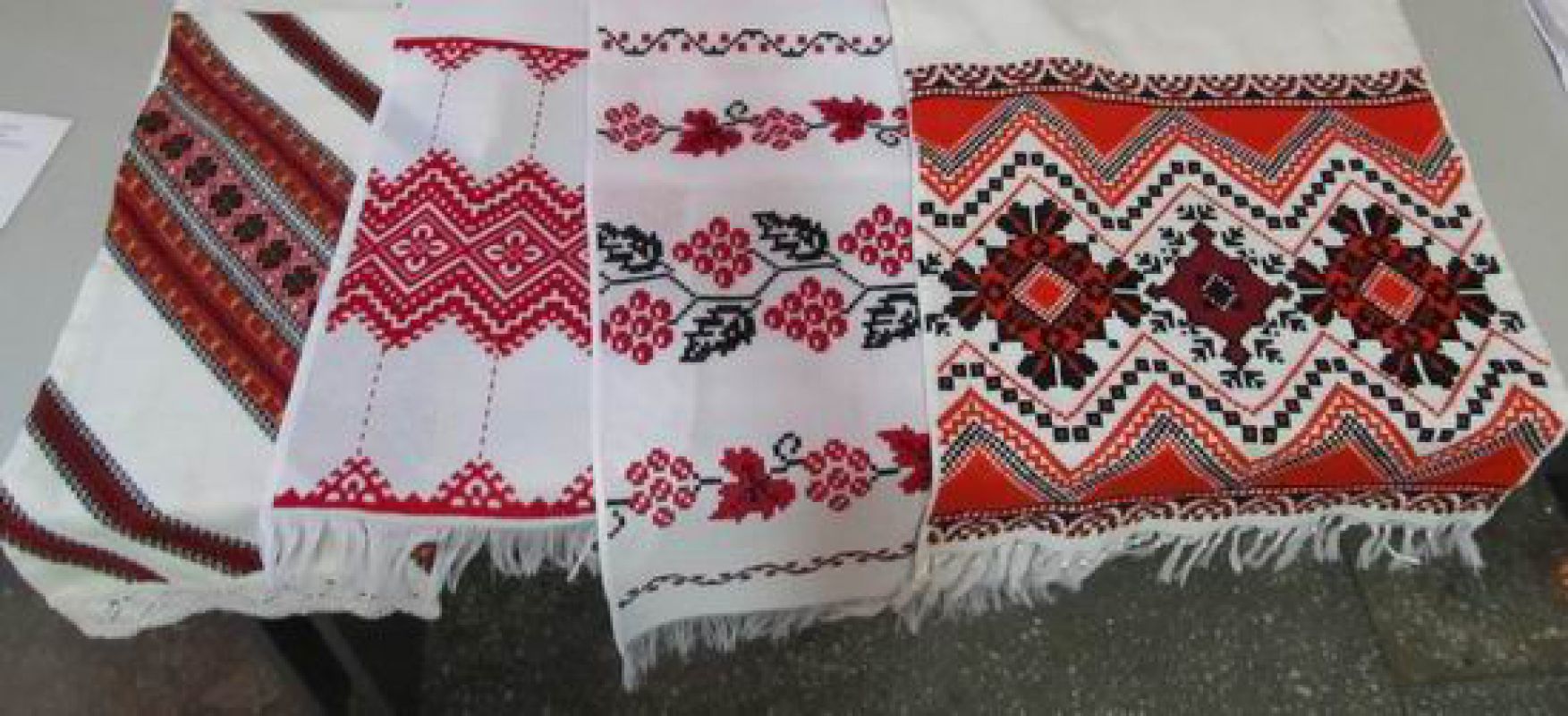
The embroidery pattern should not be cut off. Otherwise, he will not be able to protect against evil spirits. One product could not protect immediately from all troubles. Each embroidery had its own meaning and had its own power. Ritual towels in Ancient Russia were of particular importance. The patterns on them were supposed to reflect special family events. For example, a newborn midwife laid on a new towel embroidered by her mother, which protected him from the evil eye. On funeral towels, it was customary to depict symbols of loss: a rhombus (the same as the symbol of the earth, only empty).

Everyday items were embroidered with special protective symbols, mainly red roosters. The people believed that the voice of a rooster drives away demons. In order for the embroidery to acquire maximum strength, it should have been made in a day. A simple ornament, for example, the same rooster, can really be done in a day. Often embroidery-amulet was made with red threads. In addition to red, similar colors were used: brick, beetroot, scarlet, poppy, currant.
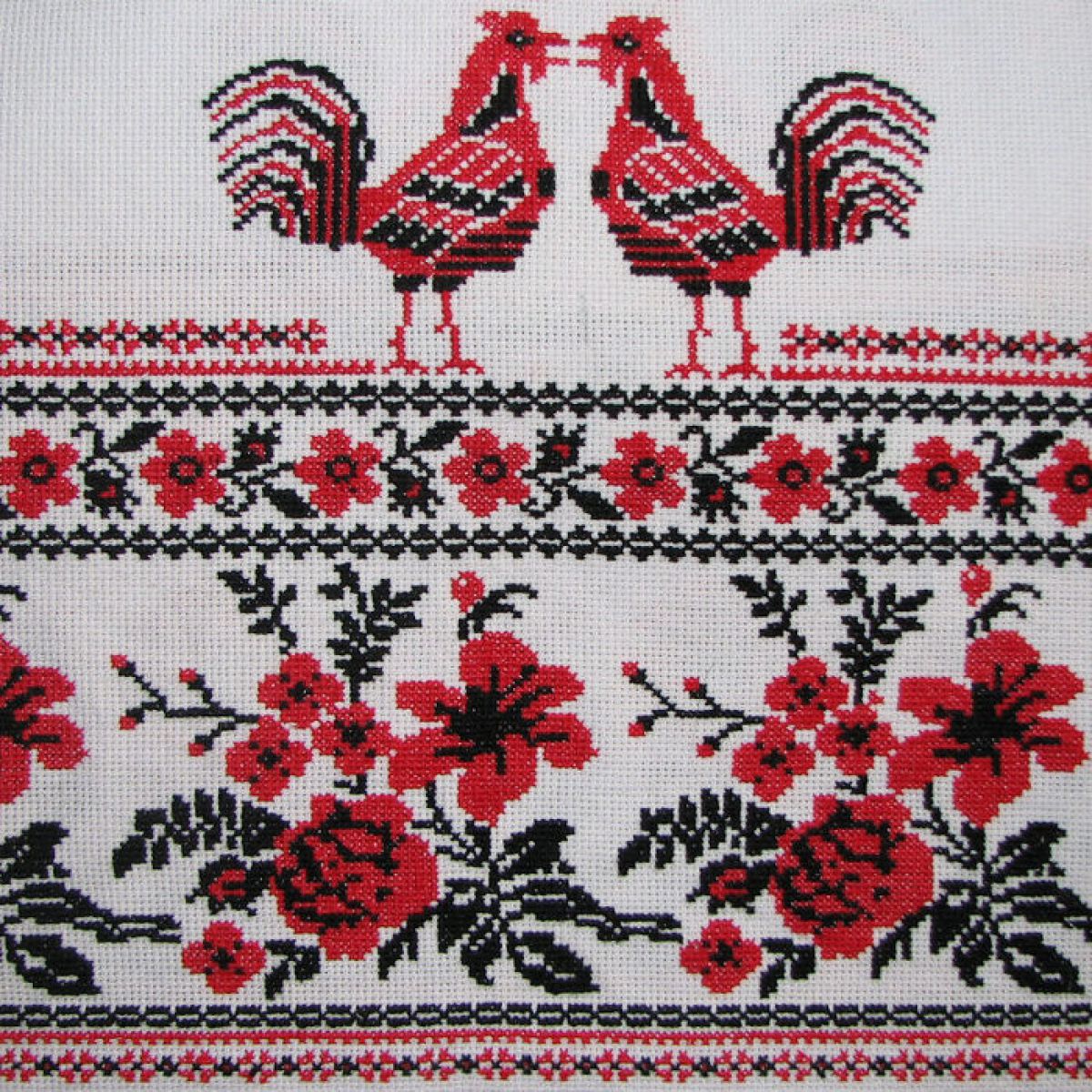
Clay bell and old key
Often an old key was hung on the wall of the hut, as it was believed that it “locked” the house from evil forces. In addition, the key was considered a symbol of prosperity and a comfortable life, since it allegedly covered the wealth of the owner. One of the most ancient Slavic amulets was a bell. It had to be made from clay with one's own hand. According to popular beliefs, his ringing could scare away any attack and evil spirits from the house.

In Ancient Russia it was unrealistic to find a hut in which there were no amulets described above. All of them are simple, thanks to which they are accessible even to a modern person. It is not difficult to make them at home, the main thing is that there is a desire.



